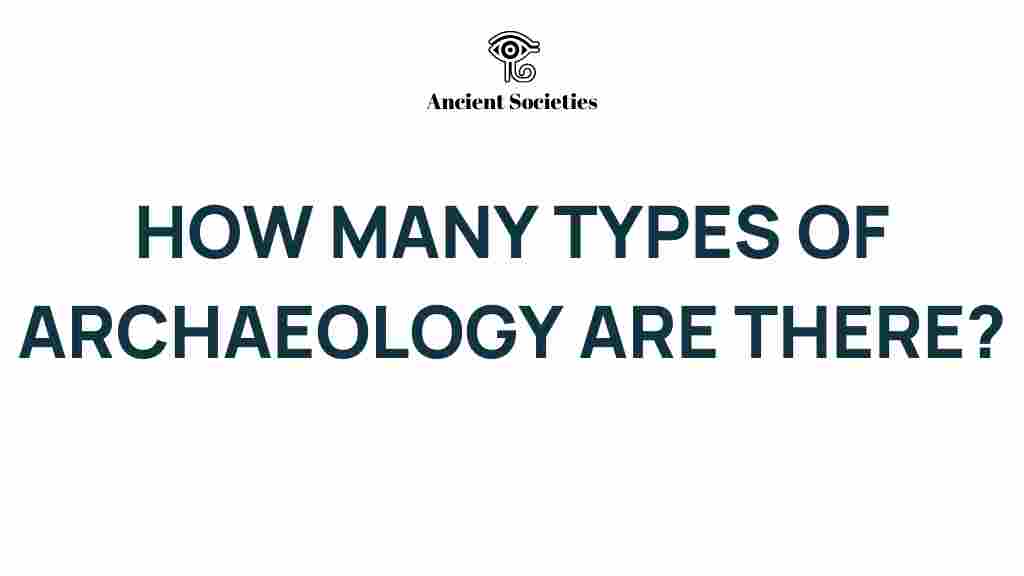Unveiling the Hidden Realms: How Many Types of Archaeology Exist?
Archaeology is a fascinating field that unveils the mysteries of our past. Through various techniques and methodologies, archaeologists explore ancient civilizations, cultural heritage, and the remnants of human activity. With a rich history rooted in exploration and discovery, the discipline of archaeology encompasses a wide array of types, each focusing on different aspects of human life and history. In this article, we will delve into the diverse types of archaeology, exploring their significance, methodologies, and the vital role they play in preserving our cultural heritage.
The Importance of Archaeology
Archaeology is crucial for understanding human history and prehistory. It provides insights into how ancient civilizations lived, their social structures, economies, and belief systems. By studying artifacts, structures, and other remains, archaeologists can reconstruct past environments and cultures, which contributes to our historical research and knowledge.
Types of Archaeology
There are several types of archaeology, each with its own distinct focus and methods. Here, we will explore the most prominent types:
- Prehistoric Archaeology: This type focuses on human history before recorded history. It examines artifacts and sites from the earliest human societies to the advent of writing.
- Historical Archaeology: This branch studies societies that have written records, using both documents and material remains to understand their development.
- Classical Archaeology: Focused on ancient Mediterranean civilizations, particularly the Greeks and Romans, this type studies their art, architecture, and everyday life.
- Underwater Archaeology: This fascinating subfield investigates submerged sites, including shipwrecks and coastal settlements, offering unique insights into maritime cultures.
- Industrial Archaeology: This area explores the material remains of the industrial past, examining factories, machinery, and other artifacts related to industrialization.
- Environmental Archaeology: This type studies the relationship between humans and their environments, focusing on how ancient peoples adapted to ecological changes.
- Ethnoarchaeology: Combining ethnography and archaeology, this approach examines contemporary societies to better understand the archaeological record of past cultures.
Excavation Methods in Archaeology
Fieldwork is a fundamental aspect of archaeology, involving careful excavation methods to uncover artifacts and structures. Here are some common techniques used in archaeological excavations:
- Stratigraphic Excavation: This method involves digging in layers (strata) to understand the chronological sequence of artifacts and features.
- Open-Area Excavation: Used for large sites, this technique allows archaeologists to expose a broader area, helping to understand spatial relationships among artifacts.
- Vertical Excavation: Focused on a single point, this method helps to uncover deep stratigraphic sequences.
- Site Survey: Before excavation, archaeologists often conduct surveys to locate potential archaeological sites and assess their significance.
Archaeological Sites and Their Significance
Archaeological sites are vital for understanding human history. These sites can vary in size and complexity, from large urban centers to small campsites. Some notable types of archaeological sites include:
- Urban Sites: Cities like Pompeii and Teotihuacan provide insights into complex societies and their infrastructures.
- Burial Sites: Tombs and cemeteries reveal beliefs about death and the afterlife.
- Ritual Sites: Places of worship or ceremonial gatherings, such as Stonehenge, offer clues about religious practices.
- Settlements: Sites where people lived, including villages and farms, highlight daily life and economic activities.
Challenges in Archaeology: Troubleshooting Tips
Archaeologists often face challenges during their fieldwork and research. Here are some common issues and tips for overcoming them:
- Site Preservation: Environmental factors and human activities can threaten archaeological sites. Implementing conservation measures is essential for preservation.
- Funding and Resources: Archaeological projects often require significant funding. Developing partnerships with universities, institutions, and local governments can help secure necessary resources.
- Community Engagement: Involving local communities in archaeological projects fosters support and enhances cultural heritage awareness.
- Data Management: Proper documentation and storage of artifacts and findings are crucial. Utilizing modern technology can streamline data management processes.
Preservation of Cultural Heritage
Preserving cultural heritage is one of the primary goals of archaeology. This involves not only protecting archaeological sites but also ensuring that the knowledge gained from them is shared with the public. Here are some strategies for effective preservation:
- Legal Protection: Implementing laws and regulations to protect archaeological sites from looting and development is vital.
- Public Education: Creating educational programs and resources can help raise awareness about the importance of cultural heritage.
- Site Management Plans: Developing comprehensive management plans for archaeological sites ensures their ongoing protection and sustainability.
- Collaboration with Indigenous Peoples: Working with local communities and indigenous groups can enhance the preservation of their cultural heritage.
Conclusion
Archaeology is a multifaceted discipline that encompasses various types, each contributing to our understanding of human history and cultural heritage. Through diverse excavation methods and meticulous fieldwork, archaeologists uncover the remnants of ancient civilizations, providing invaluable insights into our past. The preservation of these archaeological sites is essential for future generations to learn from and appreciate the rich tapestry of human history.
By exploring the different types of archaeology and their significance, we can better understand the complexities of our heritage and the importance of preserving it for future generations. To learn more about the fascinating world of archaeology, consider visiting this resource or exploring local archaeological sites near you.
As we continue to unveil the hidden realms of our past, the role of archaeology in enriching our understanding of human existence remains paramount.
This article is in the category Archaeology and created by AncientSocieties Team
